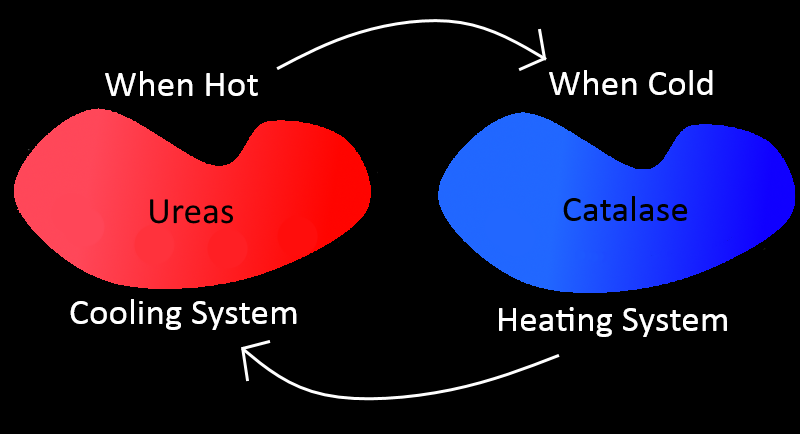Team:AUC TURKEY/Mechanism

Mechanism
The constructed system is composed of two functional systems acting against one another. There are two systems; the urease system - which is the primary system - is active at higher temperatures and the catalase system is active at lower temperatures. The two systems are meant to function inversely, as they have opposite functional roles.
The regulation of the two systems have to shift with temperature changes to provide a ‘smart’ thermoregulator system. RNA Thermometers resolve the issue of heat sensing. Through the installation of an RNA Thermometer into the sequence of the systems as an RBS, the protein translation of urease and catalase can be managed with temperature. At this point, the proper adaptation of the RNA Thermometer to the systems plays a crucial role.
There are two systems that the RNA Thermometer can be installed to. The system that has to be adapted for has to be the system that functions at higher temperatures as the RNA Thermometer allows ribosomal binding at elevated temperatures. The urease system fits this description as it is required of the urease system to increase translation levels as the temperature increases.
Another question lingers however, what of the catalase system? The catalase system will require increased production levels as the temperature decreases. Then a heat-shock RNA Thermometer will not be functional for the catalase system. This leaves behind several options with two being the most apaparent:
a)The use of a cold-shock RNA Thermometer
A cold-shock thermometer could have been adapted to the system, but there exist several issues with cold-shock thermometers. The major issue is the lack of research on and the characterization of these RBS structures. The second major handicap is the lack of respective temperatures of the cold-shock thermometers that will allow inverse operation. There will be a temperature range in which both systems will not operate, as the heat-shock protein will be closed because the temperature is not high enough and the cold-shock protein will also be closed because this inadequately high temperature will prevent it from initiating translation. Instead, there is an alternative:
b)The installation of the lac operon to the systems With the installation of the lac operon, the need for an RNA Thermometer on both systems is lifted. The RNA Thermometer on the urease system will regulate both systems with the function of the lac operon.The lac operon will allow the inverse functioning of the two systems. This will be achieved through installing the lac operon to the catalase system. As the temperature increases, the lacI attached after the RNA Thermometer will inhibit the catalase system through inhibiting the lacO. This will close the heating process at higher temperatures.
In lower temperatures the RNA Thermometer will shift to a closed structure, also stopping lacI stimulation and allowing the lacO affected catalase system to operate.
With this construct the complete system will have two main functional states in two temperature levels. The critical temperature for the ibPB RNA Thermometer is 32 C, as it is at this temperature that a recognizable level of translation is stimulated by the ibPB Thermometer. Some of the strains in the bacterial medium start to open at 32 C, so it would be best to consider temperatures below 32 C as cold and the temperatures above 32 C as hot.
So there are two states of function:
| When Hot
The RNA Thermometer is active when hot, meaning that the translation of urease following it will occur. The lac operon of catalase will be inhibited by the the lacI. Urease synthesis will occur to start cooling, the catalase translation will be inactive. |
When Cold
The RNA Thermometer will be inactive when cold, meaning that the translation of urease will not occur. lacI will not be produced and lacO will not be inhibited. Catalase synthesis will occur to start heating, the urease translation will be inactive. |
The tertiary construct containing the lacI was designed as an independent construct in this project, but it does not have to be an independent sequence. The part could have also been attached at the end of catalase to show the same functions. It can not be at the end of urease, however.
Through this construct, we now have a smart thermoregulator system.












